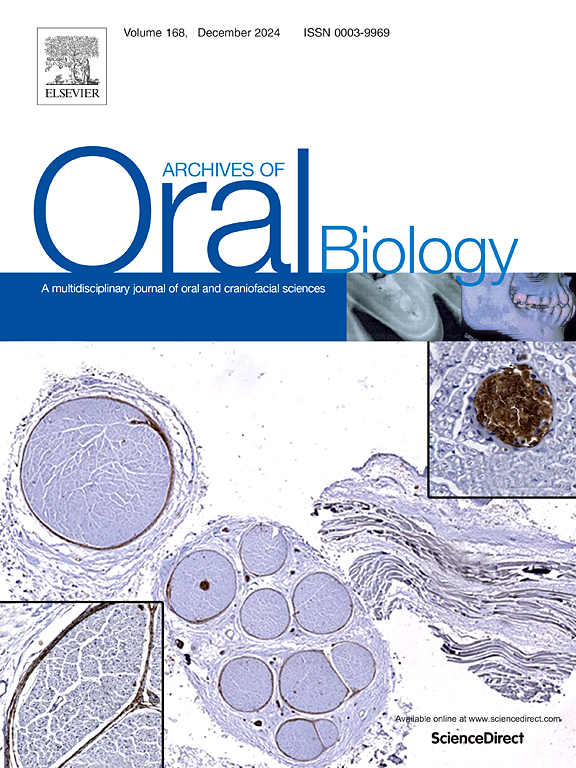用 17-α 雌二醇长效治疗遗传多样性 HET3 雄性小鼠颅面组织老化的特征。
IF 2.2
4区 医学
Q2 DENTISTRY, ORAL SURGERY & MEDICINE
引用次数: 0
摘要
目的:本研究的目的是:1)在新的、基因多样化的HET3小鼠模型中表征颅面组织衰老;2)确定17- α雌二醇(17αE2)治疗是否延长了雄性小鼠的寿命,也改善了这些组织的健康。HET3小鼠是美国国家衰老研究所(National Institute of Aging)首选和推荐的四种杂交品种,用于确定长寿疗法,并测试它们减少与年龄相关的疾病的能力。先前的报告显示,给药17αE2后,HET3雄性小鼠的寿命增加,而雌性小鼠则没有。设计:雄性小鼠饲养至大约8个月(幼年)、16个月(中年)和25个月(老年)。中老年小鼠连续19周饲喂添加17αE2的日粮。我们量化颅面组织的体积和密度变化与显微计算机断层扫描和组织学。结果:显微ct显示牙槽骨体积和骨密度不随年龄和治疗变化。牙釉质体积和密度随年龄而变化,但不随处理而变化。组织学显示牙周韧带(PDLs)随年龄的增长而发生区域特异性变性。细胞骨质密度随年龄的增长而下降,但体积没有变化。17αE2处理后,牙骨质体积和密度增加。牙本质体积随年龄增长而增大,密度随年龄增长而减小,而17αE2处理的牙本质体积随年龄增长而减小。结论:HET3小鼠为研究牙齿老化的异质性和长寿干预的效果提供了良好的模型。我们提供了关于17αE2如何通过改变雄鼠磨牙本质和牙骨质的年龄相关变化来改善健康寿命的新数据。本文章由计算机程序翻译,如有差异,请以英文原文为准。
Characterization of craniofacial tissue aging in genetically diverse HET3 male mice with longevity treatment of 17-alpha estradiol
Objective
The objective of our study was to 1) characterize craniofacial tissue aging in the new, genetically diverse HET3 mouse model; and 2) ascertain whether increased longevity with 17-alpha estradiol (17αE2) treatment in male mice also improved the health of these tissues. The HET3 mice are a four-strain cross preferred and recommended by the National Institute of Aging to identify longevity treatments and test their ability to reduce age-related pathologies. Previous reports demonstrated increased longevity in male, but not female, HET3 mice with 17αE2 administration.
Design
Male mice were raised to approximately 8 months (young), 16 months (middle-aged), and 25 months (old). Middle-aged and old mice were administered a diet supplemented with 17αE2 for 19 weeks. We quantified craniofacial tissue volume and density changes with micro-computed tomography followed by histology.
Results
Micro-CT showed that the alveolar bone volume and density did not change with age or treatment. Enamel volume and density changed with age but not treatment. Histology revealed region-specific degeneration of periodontal ligaments (PDLs) with age. Cellular cementum demonstrated age-related density decreases but no change in volume. However, cementum volume and density increased with 17αE2 treatment. Dentin volume increased with age whereas density decreased with age, which were attenuated by 17αE2 treatment.
Conclusions
The HET3 mice present an excellent model with which to study the heterogeneous nature of tooth aging and the effects of longevity interventions. We provide novel data on how 17αE2 improves healthspan by modifying age-related changes in the molar dentin and cementum of male mice.
求助全文
通过发布文献求助,成功后即可免费获取论文全文。
去求助
来源期刊

Archives of oral biology
医学-牙科与口腔外科
CiteScore
5.10
自引率
3.30%
发文量
177
审稿时长
26 days
期刊介绍:
Archives of Oral Biology is an international journal which aims to publish papers of the highest scientific quality in the oral and craniofacial sciences. The journal is particularly interested in research which advances knowledge in the mechanisms of craniofacial development and disease, including:
Cell and molecular biology
Molecular genetics
Immunology
Pathogenesis
Cellular microbiology
Embryology
Syndromology
Forensic dentistry
 求助内容:
求助内容: 应助结果提醒方式:
应助结果提醒方式:


